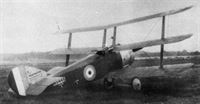Фотографии
-
Mr R. Dallas Brett, OBE, this month’s contributor, took these photographs at Sopwith’s Brooklands test depot in 1917, when he was working there during his school holidays (lucky chap!). He is seen here, aged 16, posing in front of a Clerget-engined F.1 Camel.
Самолёты на фотографии: Sopwith Camel / F.1 - Великобритания - 1916
-
The sole example of the Sopwith F.1/1 taperwing Camel, tested at Martlesham Heath in May 1917. Powered by a 130 h.p. Clerget rotary, its wings tapered from 5ft chord at the centre section to 3ft 6in at the tips, and wide, plank-like interplane struts were fitted. Its performance proved no better than that of the standard Camel, and as the wing would have been more complicated to build it is no surprise that the type was abandoned. A B.E.2e is in the background.
Самолёты на фотографии: RAF B.E.2e - Великобритания - 1916Sopwith Camel / F.1 - Великобритания - 1916
-
A standard Clerget-powered F.1 Camel fresh from the factory, the marked dihedral of its lower wings contrasting with the level upper surface. The first F.1 was passed by Sopwith's experimental department on December 22, 1916, and deliveries commenced on May 7 the following year. The name Camel was unofficial, being bestowed on the type by service pilots owing to the accentuated humped fairing over the gun breeches.
Самолёты на фотографии: Sopwith Camel / F.1 - Великобритания - 1916
-
Регистрационный номер: B3950 Sopwith-built F.1 Camel B3950, last of the second Sopwith-built batch, has an engine run-up prior to testing. Standard armament was a pair of fixed 0.303in Vickers machine guns synchronised to fire between the propeller blades. Because engine, fuel, pilot and armament were all closely grouped at the front, and because of the rotary engine's powerful torque reaction, coarse rudder was required to correct tendencies of the nose to rise in a left-hand turn and drop in a turn to the right. This made the Camel a tricky machine to master, but endowed it with extraordinary combat manoeuvrability.
Самолёты на фотографии: Sopwith Camel / F.1 - Великобритания - 1916
-
Регистрационный номер: B6203 A superb study of a new F.1 Camel just as its Clerget rotary fires, blasting a cloud of exhaust smoke and burnt castor oil lubricant fumes into the face of the unfortunate gentleman on its tail. The prop-swinger can be seen ducking away on the extreme left of the picture, while a man in a white overall looks over the shoulder of the chap in the cockpit. Awaiting attention in the background is F.1 B6203 of the third and last Sopwith batch. By far the greater number of Camels were built by sub-contractors.
Самолёты на фотографии: Sopwith Camel / F.1 - Великобритания - 1916
-
Регистрационный номер: A487 Avro 504A A487 was a product of the Bleriot & SPAD works, also based at Brooklands. One of a batch of 50 (A462-511), it is here seen being refuelled. Powered by the 80 h.p. Gnome rotary, the 504A was built in large numbers.
Самолёты на фотографии: Avro Avro 504 - Великобритания - 1913
-
Регистрационный номер: N5445 Sopwith Triplane N5445 was from Sopwith's first production batch of the type. Usually powered by the 130 h.p. Clerget 9B rotary engine, the Triplane entered service with the Royal Naval Air Service on the Western Front in late 1916, but enjoyed only a brief front-line career before it was replaced by the Camel in the summer of 1917.
Самолёты на фотографии: Sopwith Triplane - Великобритания - 1916
Статьи
- -
- News Spotlight
- Personal album
- Skywriters
- Travel Air Model R /Preservation Profile/ (61)
- ??? - Vega
- ??? - Vintage Siskin Colour
- A.Jackson - Avro 504K /RAF Piston Trainers/ (1)
- A.Jackson - Crawford Monoplane /British pre-war ultralights/
- B.Gunston - Firebrand
- C.Baker - A Fairey for Athens
- I.Goold - Airshow and Museums Guide
- J.May - Trixie, Jumbo and Co






